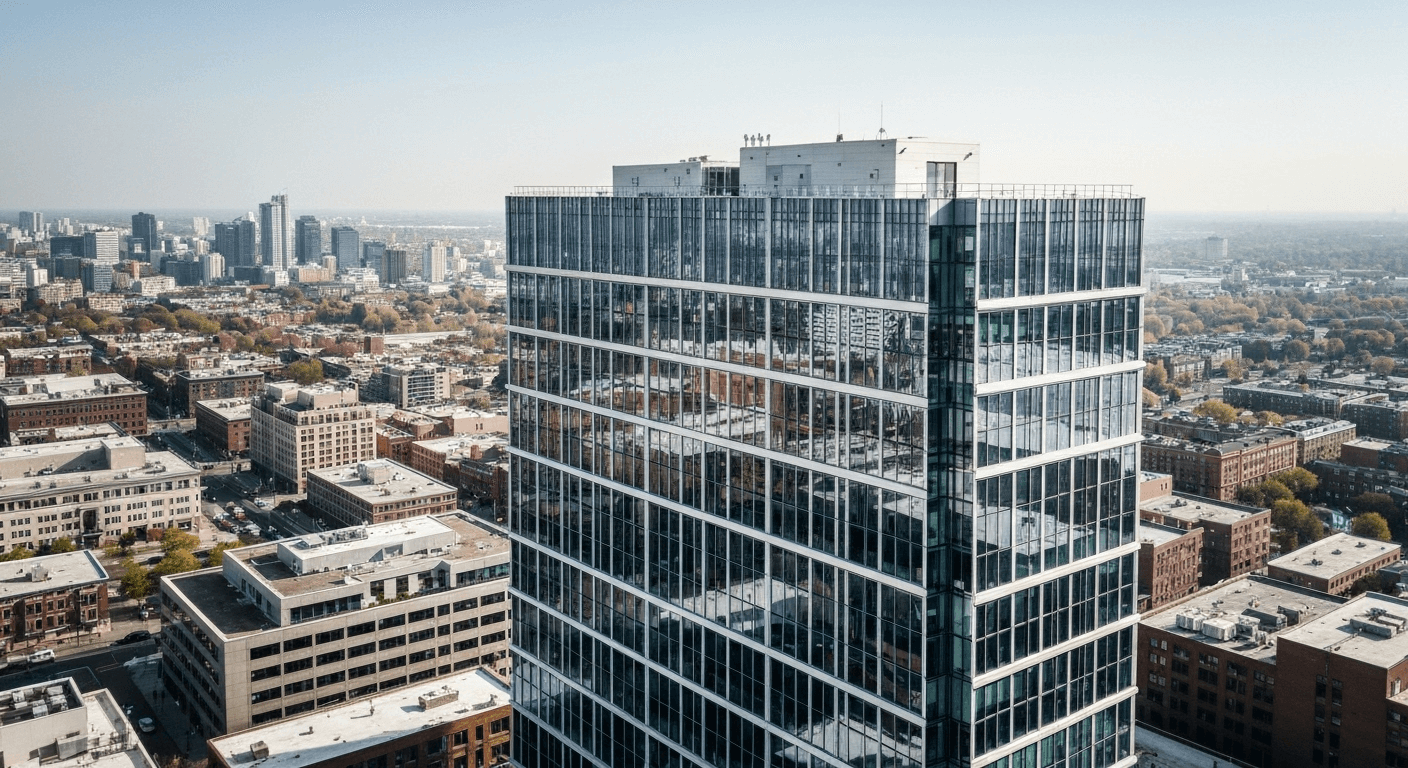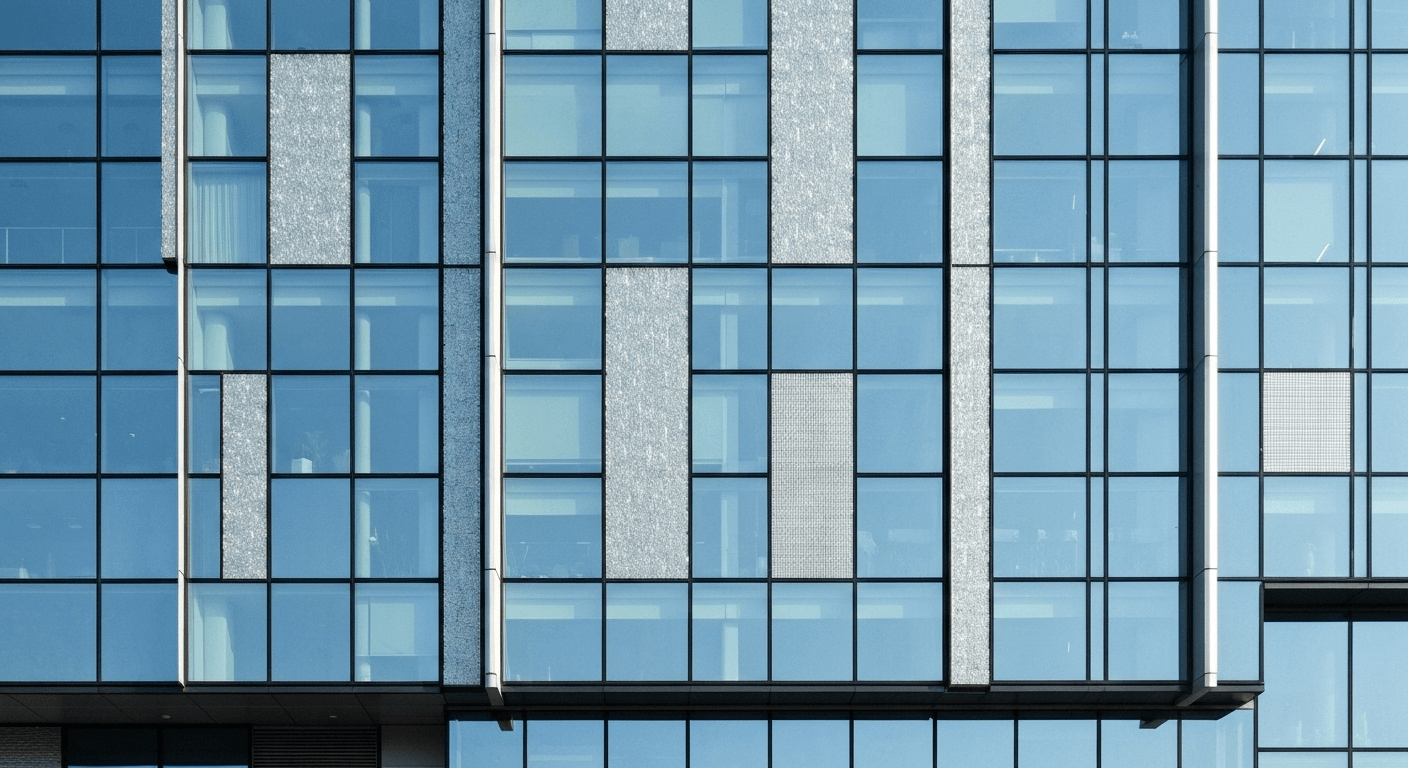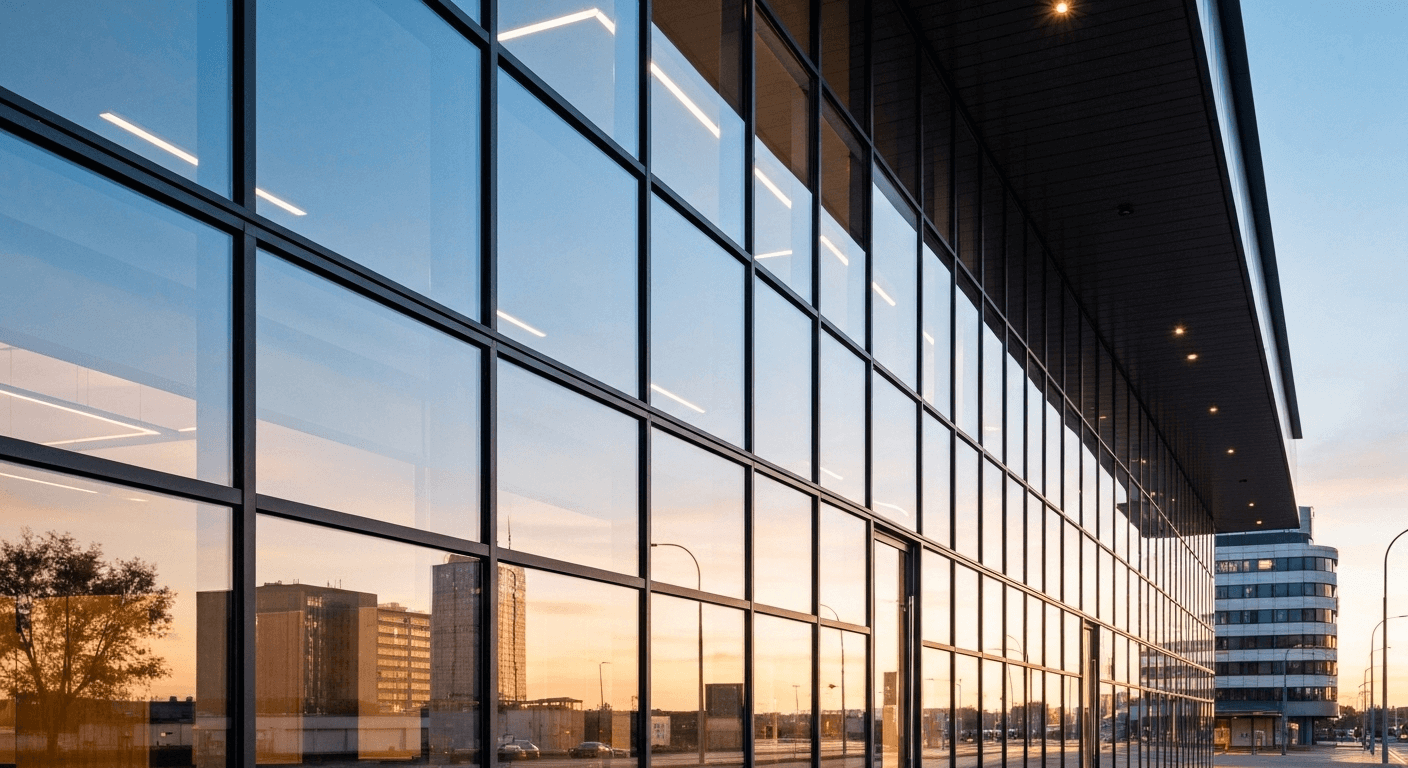Benefits of Glass Curtain Walling for Your Project
发布时间:
2025-10-13 16:49
来源:
huizeglass

Key Highlights
- A glass curtain wall provides a non-structural outer layer for a building, offering a sleek, modern look.
- It maximizes natural light, creating bright and open interior spaces with expansive views.
- This system offers incredible design flexibility with various glass types, frames, and finishes.
- High-performance glazing improves thermal insulation and energy efficiency, helping to lower utility costs.
- A unitized curtain wall system can be prefabricated, which speeds up installation time on the job site.
- Curtain walls protect the building structure from environmental elements like wind and rain.
Introduction
Are you looking for a way to give your next building project a stunning, modern facade? A glass curtain wall) might be the perfect solution. This system acts as the outer covering, or building envelope, creating a seamless glass surface that is both beautiful and functional. It offers incredible design flexibility, allowing architects to design eye-catching exteriors while bringing abundant natural light into the interior. Let's explore why this choice is so popular for today’s commercial buildings.
Understanding Glass Curtain Walling
A glass curtain wall is essentially a non-structural covering for a building. Unlike traditional walls, it doesn't support the building's weight. Instead, it hangs from the main building structure, much like a curtain, protecting it from the elements. This design is what allows for large, uninterrupted spans of glass.
The system is typically composed of a lightweight frame, such as aluminum, which holds glass or opaque panels. This setup with its vertical mullions provides structural integrity for the wall itself while allowing for incredible design flexibility. We will look closer at what defines these systems, how they differ from other options, and their key parts.
Defining Glass Curtain Wall Systems
A glass curtain wall system is an exterior covering attached to the building structure, forming a non-structural building envelope. It is designed to resist wind and weather, but it does not carry any of the building's roof or floor loads. Its primary job is to keep the weather out and the occupants comfortable.
The system is made up of glass panels held in place by a frame. This frame is anchored to the floor slabs of the building. A key feature of a curtain wall is its ability to manage differential movement between the wall and the main structure, which is crucial for tall buildings that can sway in the wind.
This separation from the main structure is what gives architects so much freedom. They can create a continuous exterior glass facade without being limited by the need for structural support at every window opening. This results in the sleek, modern look that defines many contemporary skyscrapers.
Key Differences Between Glass Curtain Wall and Window Wall
People often confuse a glass curtain wall with a window wall, but they are structurally different. The main distinction lies in how they are attached to the building. A curtain wall is hung on the exterior of the building structure, typically spanning multiple floors.
In contrast, a window wall system is installed between the floor slabs. It is essentially a series of large windows that fill the space from one floor to the next. This means a window wall is supported by the slab at its bottom and top on each floor.
Here are the key differences:
- Installation: A curtain wall is installed outside of the floor slabs, while a window wall sits between them.
- Load Bearing: A curtain wall is non-structural and only supports its own weight. A window wall is also non-load-bearing but is supported by the structure on each floor.
- Span: Curtain walls can span multiple stories, creating a more unified facade. Window walls are limited to single-floor spans.
Primary Components of Glass Curtain Walling
A glass curtain wall might look simple, but it's a complex system with several key components working together. These parts ensure the wall is stable, weather-tight, and visually appealing. The main elements include the curtain wall framing, the glass units, and the anchoring system that connects it all to the building.
The framing, usually made of aluminum, consists of vertical mullions and horizontal rails that create a grid. The glass units are then placed within this grid. Gaskets and sealants are used to prevent air and water infiltration and to allow for thermal expansion. These components are engineered to withstand wind loads and other environmental pressures.
Here is a breakdown of the primary components:
| Component | Description |
|---|---|
| Framing | Consists of vertical mullions and horizontal transoms, typically made from aluminum or steel. |
| Glass Units | Can be single-paned, double-glazed, or triple-glazed units for thermal performance. |
| Anchors | Brackets and bolts that secure the curtain wall framing to the main building structure. |
| Spandrel Panels | Opaque panels used to hide floor slabs and other structural elements, creating a seamless look. |
| Gaskets & Sealants | Used to create a barrier against water and air, ensuring the building envelope is secure. |
Types of Glass Used in Curtain Wall Systems

The type of glass you choose for your curtain wall system has a huge impact on both its appearance and performance. You aren't limited to just one option; there are many different types of curtain walls, and the glass is a key variable. The right glass can enhance safety, improve thermal insulation, and control sound.
From standard options to high-performance specialty glass, your choice will depend on your project's specific needs, climate, and design goals. Let's look at some of the most common glass types used in a modern glass curtain wall.
Tempered and Laminated Glass Options
When it comes to safety, tempered glass is a top choice. This glass is treated with heat to make it about four times stronger than regular glass. If it does break, it shatters into small, dull-edged pieces rather than sharp shards, reducing the risk of injury. This makes it a great option for curtain wall design, especially in high-traffic areas.
Another excellent safety option is laminated glass. This type is made by bonding a layer of plastic, usually polyvinyl butyral (PVB), between two or more layers of glass. If the glass breaks, the pieces stick to the plastic interlayer instead of falling.
Laminated glass not only enhances safety but also offers better sound insulation and can block up to 99% of UV radiation. For projects where security and safety are top priorities, combining tempered and laminated glass offers the best of both worlds.
Performance Glass for Thermal Insulation
One of the biggest concerns with large glass facades is energy efficiency. Performance glass is designed to address this by improving thermal insulation and reducing heat transfer. A key technology here is the low-e (low-emissivity) coating, which is a microscopically thin, transparent layer applied to the glass.
This coating reflects heat, keeping it outside in the summer and inside in the winter. This helps maintain a comfortable indoor temperature and significantly lowers heating and cooling costs. Low-e coatings are essential for achieving high thermal efficiency in modern buildings.
To further boost thermal performance, these coated glass panels are often used in double or triple-glazed insulated glass units (IGUs). The space between the glass panes is filled with an inert gas like argon, which is a poor conductor of heat. This combination drastically reduces heat transfer and improves the overall energy performance of the curtain wall.
Specialty Glass for Sound and Solar Control
Beyond safety and insulation, specialty glass can be used to control sound and sunlight. For buildings in noisy urban areas, acoustic glass is an excellent choice for sound control. This glass is typically a form of laminated glass with a special interlayer that dampens sound vibrations, reducing noise transmittance from the outside.
Solar control glass is designed to manage the amount of sunlight and heat that enters a building. It can reduce glare and prevent interiors from overheating, which is especially important for buildings with large glass surfaces. This creates a more comfortable environment for occupants.
Here are some specialty glass benefits:
- Sound Control: Reduces outside noise for a quieter interior, ideal for offices or residential buildings near busy streets.
- Solar Control: Minimizes glare and heat gain, improving comfort and reducing the need for air conditioning.
- Bird-Friendly Design: Glass with special patterns or UV coatings can help prevent bird collisions, an important consideration for sustainable design.
Building Materials Supporting Glass Curtain Walls
While glass is the star of the show, the materials supporting it are just as important. The curtain wall framing provides the necessary structure to hold the glass panels in place and attach the entire system to the building structure. The choice of material affects the wall's strength, appearance, and thermal performance.
The most common materials used for framing are aluminum and steel. Each has its own set of advantages and is suited for different design requirements. Let's examine the differences between an aluminum and a steel curtain wall and compare framed versus frameless systems.
Aluminum vs. Steel Frames Explained
Aluminum is by far the most popular material for curtain wall frames. It is lightweight, strong, and highly resistant to corrosion, making it a durable and low-maintenance choice. Aluminum frames can also be easily extruded into complex shapes, offering great design flexibility.
Steel frames are another option, known for their incredible strength. This allows them to support very large and heavy glass panels with slimmer profiles than aluminum. However, steel is heavier and more susceptible to rust if not properly treated. Both aluminum and steel frames can incorporate thermal breaks—a piece of low-conductivity material placed in the frame to reduce heat transfer.
Here’s a quick comparison:
- Aluminum Frames: Lightweight, corrosion-resistant, and versatile in design. The most common choice for commercial buildings.
- Steel Frames: Extremely strong, allowing for larger glass spans and thinner sightlines. Heavier and requires corrosion protection.
- Thermal Breaks: Can be added to both frame types to improve insulation and energy efficiency.
Frameless vs. Framed Curtain Wall Systems
The choice between a frameless and a framed system largely comes down to the desired aesthetic. A framed system is the traditional approach, where an aluminum or steel grid is visible on the exterior, outlining each glass panel. This grid provides clear structural expression and can be customized with different finishes and snap cover profiles.
A frameless curtain wall, on the other hand, aims to create the most seamless glass surface possible. In these systems, the glass panels are held in place with structural silicone or mechanical clips that are hidden from view. This gives the building a sleek, modern look with an uninterrupted glass facade.
While the "frameless" name suggests a lack of structure, the support system is simply concealed. This approach offers incredible design flexibility and is popular for high-end commercial projects that want to make a bold architectural statement. The choice depends on whether you want the frame to be a visible design element or hidden for a pure-glass appearance.
Choosing the Right Support Structure
Selecting the right support structure for your glass curtain wall is a critical decision that impacts performance, cost, and safety. The choice depends on several factors, including your specific design requirements, local building codes, and the building's overall structural system. You need to consider how the curtain wall will be anchored and how it will handle forces like wind load.
Your architect and structural engineer will work together to determine the best approach. They will analyze the building's design, the size and weight of the glass units, and the environmental conditions at the job site. For example, a high-rise building in a windy city will have very different requirements than a low-rise building in a calm climate.
Here are some key things to consider:
- Building Codes: Ensure the structural system meets all local safety and performance regulations.
- Aesthetic Goals: Decide if you want a visible frame or a frameless look, which will influence the choice of materials and anchors.
- Performance Needs: The support structure must work with the glass to achieve the desired thermal and acoustic performance.
Advantages of Glass Curtain Walling for Facades

Using a glass curtain wall for your building's facade offers a host of benefits that go beyond just good looks. These systems transform the building envelope into a high-performing feature that enhances the experience for everyone inside. One of the most significant advantages is the huge amount of natural light they let in.
In addition to creating bright, welcoming spaces, glass curtain walls can dramatically improve a building's energy efficiency and offer unparalleled design freedom. Let's dive into these key advantages to see why so many architects make this their ideal choice.
Maximizing Natural Light and Views
One of the most compelling reasons to choose a glass curtain wall is its ability to maximize natural light. The continuous exterior glass allows daylight to flood deep into the interior of the building, reducing the need for artificial lighting. This not only saves energy but also creates a more pleasant and productive environment for occupants.
Studies have shown that access to natural lighting and views can improve well-being and productivity, making it a valuable feature for commercial buildings like offices and hospitals. A curtain wall provides expansive, floor-to-ceiling views that connect people inside with the world outside, helping them feel less confined.
This design flexibility creates a sense of openness that is difficult to achieve with traditional walls and punched windows. For any project where a bright, airy atmosphere is a priority, a continuous exterior glass facade is an unbeatable choice.
Enhanced Thermal Performance and Energy Efficiency
It may seem counterintuitive, but a wall made of glass can be incredibly energy-efficient. Modern glass curtain walls are designed for high thermal performance. By using advanced glazing like low-e coated glass and insulated glass units (IGUs), these systems can provide excellent thermal insulation.
This technology works to minimize heat transfer through the building envelope. In the winter, it helps keep warm air inside, and in the summer, it reflects the sun's heat to keep the interior cool. This reduces the strain on heating and cooling systems, leading to significant energy savings over the life of the building.
Properly designed curtain walls with thermal breaks in the framing further enhance this effect. By focusing on energy efficiency, you can create a sustainable building that is not only beautiful but also cost-effective to operate.
Flexible Design and Aesthetic Options
Glass curtain walls offer architects unmatched design flexibility. You are not limited to a single look; these systems can be customized to achieve almost any aesthetic vision. The ability to mix different types of glass with opaque spandrel panels allows for creative and unique facade designs.
You can play with color, reflectivity, and transparency to create a dynamic exterior that changes with the light. The framing itself can also be a design element, with different finishes and profiles available to complement the overall look. This versatility is why curtain walls are used on so many iconic and architecturally significant buildings.
Here are a few ways to customize your design:
- Glass Variety: Combine clear, tinted, and reflective glass for visual interest.
- Spandrel Panels: Use colored or patterned spandrel panels to hide structural elements and add a pop of color.
- Framing Finishes: Choose from a wide range of colors and finishes for the aluminum or steel frames to match your design palette.
Maintenance and Care Tips for Glass Curtain Walling
A glass curtain wall is a durable and long-lasting system, but like any part of a building envelope, it requires some maintenance to stay in top condition. Proper care ensures the wall continues to perform well, preventing issues like water infiltration and maintaining its aesthetic appeal for years to come.
Routine cleaning and regular inspections are the keys to longevity. By catching small issues early, you can avoid costly repairs down the road. Let’s go over some simple tips to keep your glass curtain wall looking and functioning its best.
Routine Cleaning, Inspection, and Longevity
Regular maintenance is essential for preserving the beauty and function of your glass curtain wall. Routine cleaning is the most basic step. Dirt, dust, and pollutants can build up on the glass surface, reducing its transparency and appeal. A professional cleaning schedule should be established based on your building's location and environmental conditions.
Beyond cleaning, periodic inspection is crucial for the system's longevity. You should have professionals check for any signs of damage or wear, particularly in the gaskets and wet seals that prevent water infiltration. Damaged seals should be replaced promptly to protect the building envelope.
Following a simple maintenance plan can significantly extend the life of your curtain wall. Here are some key tasks:
- Regular Cleaning: Keep the glass clear and free of dirt buildup.
- Sealant Inspection: Check gaskets and seals for cracking, shrinking, or gaps.
- Frame Check: Inspect the framing for any signs of corrosion or damage.
- Drainage Systems: Ensure weep holes and other water diversion paths are clear of debris.
Conclusion
Choosing glass curtain walling for your next project is a decision that can significantly enhance both aesthetic appeal and functional performance. With advantages such as maximizing natural light, energy efficiency, and design flexibility, these systems not only elevate the look of your building but also contribute to its sustainability. As you consider this option, remember that routine maintenance and understanding the right materials are key to ensuring longevity and effectiveness. If you have questions or need assistance in customizing your project, don’t hesitate to contact Huize Glass for expert guidance tailored to your needs. Your vision deserves the best support, and we’re here to help!
Frequently Asked Questions
What makes glass curtain walls a better choice than traditional windows?
Glass curtain walls offer a continuous glass surface that maximizes natural light and provides panoramic views, unlike traditional windows which are smaller and interrupt the facade. They also provide greater design flexibility and can be engineered for higher energy efficiency, making them a superior choice for modern commercial buildings.
How does the installation process work for glass curtain walling?
The installation process for a curtain wall system typically involves either a stick-built or unitized method. In a unitized system, large, pre-glazed panels are assembled in a factory and then transported to the construction site for quick erection. This method speeds up installation and improves quality control.
What are common maintenance requirements for glass curtain walling systems?
Common maintenance for a curtain wall includes routine cleaning to maintain its appearance and regular inspection of seals and gaskets to prevent leaks. It's also important to check that drainage pathways are clear. This simple maintenance plan ensures the system's performance and longevity.
Important Considerations Before Starting Your Curtain Wall Project
Before starting your curtain wall design, consider local building codes, structural system requirements, and desired thermal performance. It's also crucial to plan for water diversion and to select materials that meet your project's aesthetic goals and budget. Proper planning is key to a successful installation.
Project Customization Options and CTA to Contact Huize Glass
Your project can be fully customized with endless design flexibility. From different glass types and frame finishes to unique configurations in unitized curtain wall systems, we can match your aesthetic appeal. For custom solutions for your commercial buildings, contact Huize Glass today to discuss your project needs!
Meeting Local Building Regulations and Safety Standards
It is essential that your curtain wall design complies with all local building codes and safety standards. This includes meeting requirements for wind load resistance, fire safety, and energy performance. Working with experienced professionals ensures your building structure is safe, compliant, and obtains necessary environmental product declarations.
Budgeting for Curtain Walling: Cost Factors to Know
When budgeting for a curtain wall, key cost factors include the total square foot area, the type of glass and framing materials selected, and the complexity of the design. Unitized systems may have a higher material cost but can save on-site labor expenses. The overall performance requirements also impact the final cost.
Related News




